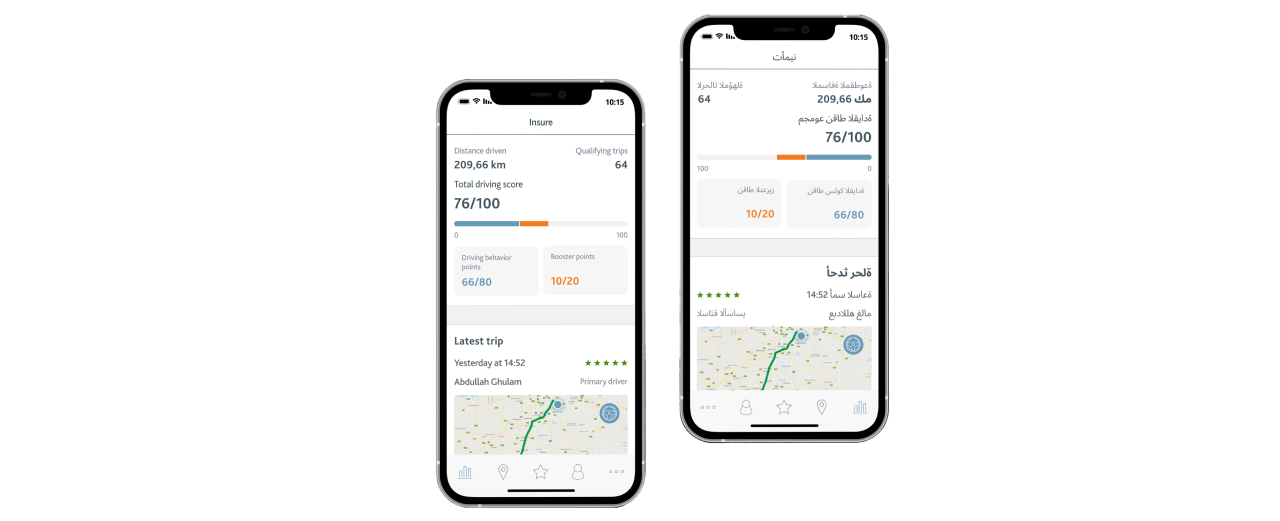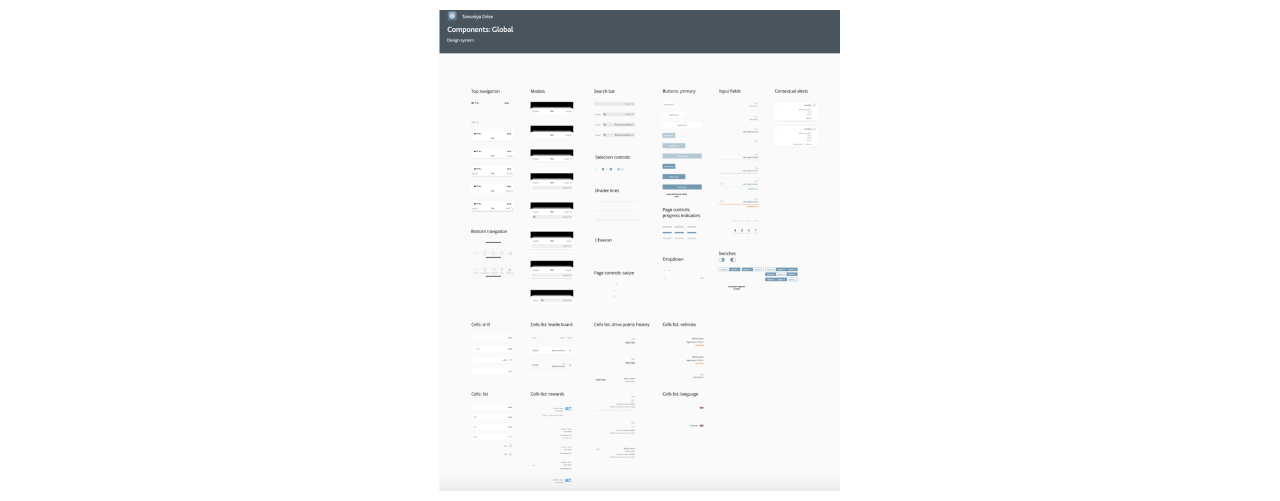Adapting Design to Saudi Arabian Culture

Discovery is a South African-founded financial services organisation that operates in the healthcare, life insurance, short-term insurance, long-term saving, banking, and wellness markets. Discovery’s core purpose is to make people healthier and to enhance and protect their lives. They do this through their shared-value insurance model.
Within the insurance space, the model provides clients with a range of pathways and incentives to lessen their personal risk and improve their behaviour through the Vitality Drive program.
In short, the model rewards people for driving well. Discovery exported this model and scaled it through the Global Vitality Network where they created an alliance with some of the largest insurers across key markets all around the world. One such partnership is Tawuniya.
Tawuniya is a Saudi Arabian insurer. Tawuniya provides its customers with more than 60 types of insurance, including car insurance. The partnership involves Discovery Insure working with Tawuniya to integrate the Vitality Drive telematics program that was originally developed for a South African market to be adapted for a Saudi Arabian context.
Challenges
Bi-directionality
Tawuniya is a multi-language app, using Arabic and English, when developing for a multi-language audience, implementing bi-directional design is crucial. Bi-directional design refers to creating interfaces that accommodate languages written from right to left (RTL), such as Arabic. This involves adapting the layout, navigation, and typography to ensure a seamless user experience for RTL readers. By incorporating bi-directional design principles, you can effectively reach and engage users from diverse linguistic backgrounds.

Cultural Appropriateness
To ensure cultural appropriateness, it is vital to conduct thorough research on the target audience's cultural norms and sensitivities. In the context of Saudi Arabian culture, our design team invested significant effort in understanding the cultural nuances and preferences. This research allowed us to make informed decisions about graphic elements and avoid potential pitfalls that could undermine user experience.
Avoiding Cultural Misinterpretation
One concrete example of cultural sensitivity in design is the avoidance of using piggybank icons in the app. While piggybank icons might be common in Western cultures as symbols of saving or finance, they hold a very different meaning in Saudi Arabian culture. Pork is prohibited in Islamic dietary practices, and associating pig-related imagery with finance could be perceived as disrespectful. By researching and understanding these cultural nuances, we were able to make thoughtful design choices and avoid potential misunderstandings.
Culturally Appropriate Graphic Elements
To ensure the graphic elements in the app were culturally appropriate, we considered various aspects, such as colours, symbols, and visual metaphors that align with Saudi Arabian culture. By incorporating elements that resonate with the target audience, we created a user experience that feels familiar and relatable. This attention to cultural appropriateness helps establish trust and enhances user engagement.
Privacy
The conservative nature of Saudi Arabian culture places a high value on privacy. Considering this, it was crucial for us to prioritise user comfort and establish trust when it came to the Drive app's tracking features. The app's primary objective is to track drivers, evaluate their drive score, and incentivise safe driving practices. By addressing users' concerns regarding data usage, tracking frequency, and transparency, we aimed to create an environment where users could confidently embrace the app and feel at ease with its functionalities.
Standardisation
The Drive solution was initially developed within the Discovery Insure app, and Tawuniya is not the first insurer to collaborate with Discovery Insure. Consequently, the Drive solution has been implemented across various apps. Recognising the need for standardisation, we aimed to align the core features, design, and implementation of the solution. This standardisation was essential to establish consistent components, resulting in reduced design and development time. By streamlining the solution, we aimed to optimise efficiency and ensure a seamless experience across all applications.
Legacy systems
Discovery Insure had developed its Drive app long before establishing partnerships with other organisations. Over time, a significant challenge arose due to the presence of outdated legacy components within the app. Updating these components posed a time-consuming task, especially considering their integration into multiple applications. To address this challenge, it became imperative to establish a forward-looking approach that would facilitate easier and faster component updates in the future. By finding a way to streamline the component update process, we aimed to enhance efficiency and ensure that the Drive app remained aligned with current mobile patterns.
Solutions
Research
In order to create a successful user experience for a multi-language audience, it is essential to consider the unique aspects of Saudi Arabian culture. In our design process, we conducted thorough research on both bi-directional design and cultural sensitivity to ensure the app resonated with the Saudi Arabian users. Key elements visited in our research include:
- Bi-Directional Design
- Cultural Sensitivity
- Avoiding Misinterpretation
Embracing an Agile Way of Work
Recognising the need for adaptability and efficiency, we decided to adopt an agile way of work. By implementing this methodology, we were able to divide our projects into smaller, more manageable tasks, known as sprints. These sprints allowed us to deliver faster and iterate on our designs more effectively.
Cross-Disciplinary Collaboration
A significant advantage of the agile approach was the opportunity it provided for cross-disciplinary collaboration. Our analysts, designers, and developers were brought closer together, fostering a collaborative environment where ideas and expertise could be shared freely. This collaboration resulted in more comprehensive and innovative solutions for our clients.
Design System
Creating a design system that was highly customisable was key to solve for our standardisation issues, as well as to future-proof components so we never have the issue of being stuck with legacy components. Having the design system in place and implemented cuts down on design and development time significantly.
What is a design system
InVison: “a collection of reusable components, guided by clear standards, that can be assembled together to build any number of applications.”
Jeremy Keith: “The generally-accepted definition of a design system is that it’s the outer circle— it encompasses pattern libraries, style guides, and any other artefacts. But there’s something more. Just because you have a collection of design patterns doesn’t mean you have a design system. A system is a framework. It’s a rulebook. It’s what tells you how those patterns work together.”
Brad Frost: “as the official story of how your organisation designs and builds digital products. There are a lot of ingredients involved in telling that story. A kit of UI components without accompanying philosophy, principles, guidelines, processes, and documentation is like dumping a bunch of IKEA components on the floor and saying “Here, build a dresser!”

Key UX/UI Design Features
Device linking
The Drive app offers users the convenience of activating and linking their telematics devices directly within the app. By providing this functionality, users can seamlessly integrate their devices, enabling them to benefit from the app's comprehensive tracking and monitoring features. One crucial aspect of this integration is the ability for users to easily check the status of their telematics devices. This feature ensures that users can verify whether their device is online and functioning properly, offering them peace of mind and confidence in the reliability of the data being collected. By empowering users to monitor the status of their telematics devices effortlessly, the Drive app enhances user engagement and fosters a sense of control and transparency over the tracking process.
Trips
Users can view their trips and their trip scores. They can change their trip types, for example, whether they were a driver or passenger on a trip. Users can view their trips on a map and see where they had points deducted on the route and why. Points will be deducted from a trip if the user had any negative driving behaviour like sharp cornering, harsh braking, and acceleration.

Rewards
Users have a wallet with virtual currency that they can spend on a variety of rewards. The wallet will be rewarded with funds if the user had an overall good status (bronze, silver, or gold). The status is determined by how well the user drives.

Results Achieved
By incorporating bi-directional design principles and conducting thorough research on Saudi Arabian culture, we were able to create an app that is not only visually appealing but also culturally appropriate and sensitive. This attention to detail demonstrates our commitment to providing a user experience that aligns with the values and expectations of the Saudi Arabian audience. Through cultural research and thoughtful design choices, we can foster a deeper connection with users, establish trust, and ultimately create a more engaging and inclusive app experience.
The implementation of a design system has proven to be highly beneficial for Tawuniya, particularly in terms of reducing the design time required for introducing new features. By establishing a set of standardised design components, guidelines, and principles, the design system has empowered the team to work more efficiently and effectively. With predefined elements readily available, designers can quickly create consistent and cohesive user interfaces, eliminating the need to start from scratch for every new feature. This streamlined approach not only saves valuable time but also ensures a seamless and visually appealing user experience throughout the app.
Tawuniya has established itself as a trailblazer in the Middle East and North Africa (MENA) region by being the first insurer to incentivise good driving behavior. Through the Drive app, Tawuniya has introduced a unique system that rewards safe and responsible driving practices. This innovative approach not only benefits drivers by promoting safer roads but also enhances Tawuniya's reputation as a forward-thinking and customer-centric insurance provider. By encouraging and rewarding good driving habits, Tawuniya sets an example for other insurers in the MENA region, illustrating the positive impact that technology-driven incentives can have on road safety and overall customer satisfaction.
